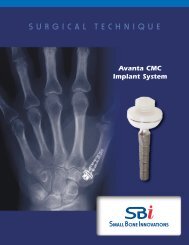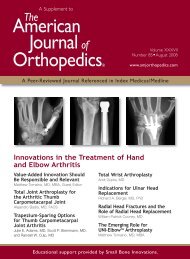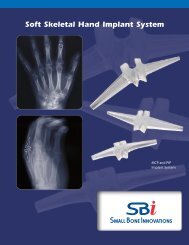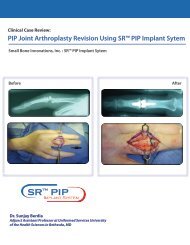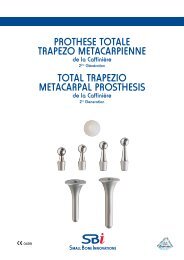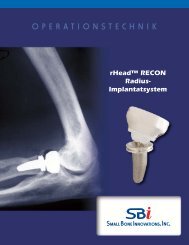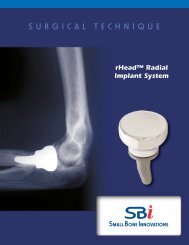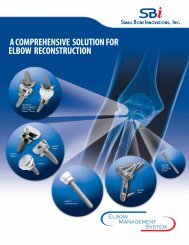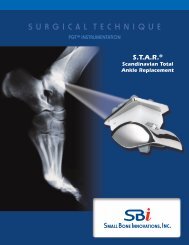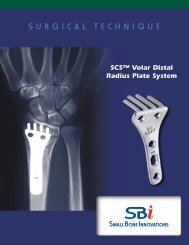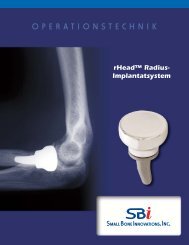Download the uHead Surgical Technique - Small Bone Innovations
Download the uHead Surgical Technique - Small Bone Innovations
Download the uHead Surgical Technique - Small Bone Innovations
You also want an ePaper? Increase the reach of your titles
YUMPU automatically turns print PDFs into web optimized ePapers that Google loves.
SURGICAL<br />
TECHNIQUE<br />
<strong>uHead</strong> Ulnar<br />
Implant System
<strong>uHead</strong> Ulnar Implant System<br />
SURGICAL TECHNIQUE<br />
CONTENTS<br />
Introduction 1<br />
Disorders of <strong>the</strong> Radioulnar Joint 2<br />
Design Rationale 3<br />
Sugical Procedure<br />
1. The Initial Incision, Ulna Approach 4<br />
Dorsal Approach Alternative 4<br />
2. Incision of <strong>the</strong> Extensor Retinaculum 4<br />
3. Ulnar Exposure of <strong>the</strong> Distal Ulna 4<br />
4. Determining Resection Length 5<br />
5. Resection of <strong>the</strong> Distal Ulna 5<br />
6. Canal Preparation 6<br />
7. Insertion of <strong>the</strong> Trial Stem 6<br />
8. Trial Head Insertion and Trial Reduction 6<br />
9. Implanting <strong>the</strong> Ulnar Stem Component 6<br />
10. Securing <strong>the</strong> Ulnar Head 7<br />
11. Ulnar Head Impaction 7<br />
12. Capsular Closure 8<br />
13. Extensor Retinaculum Closure 8<br />
14. Rehabilitation 8<br />
Indications and Contraindications 9<br />
Patient Counseling Information 9
Introduction<br />
Ligament disruption, ulnar styloid fractures, and fractures<br />
into <strong>the</strong> distal radioulnar joint are common occurrences<br />
following fractures of <strong>the</strong> distal radius and o<strong>the</strong>r rotational<br />
instability injuries of <strong>the</strong> forearm. When <strong>the</strong>re is loss of<br />
stability of <strong>the</strong> distal radioulnar joint, <strong>the</strong>re is subsequent<br />
weakness in grip and pinch as well as potential loss of<br />
forearm rotation. Operative procedures with respect to<br />
treating <strong>the</strong> distal radioulnar joint have been to stabilize<br />
<strong>the</strong> ligaments about <strong>the</strong> joint or to resect <strong>the</strong> entire head<br />
of <strong>the</strong> distal ulna (Darrach procedure or equivalent).There<br />
have been variable results associated with <strong>the</strong> partial or<br />
complete resections of <strong>the</strong> distal ulna, particularly those<br />
performed by open resection. Similarly, ligament reconstruction<br />
of <strong>the</strong> distal ulna may be incomplete in restoring<br />
stability. With ulnar resection, both instability of <strong>the</strong> wrist<br />
and “snapping” of <strong>the</strong> forearm in rotational pronation/<br />
supination can occur. To date, <strong>the</strong> distal ulna remains an<br />
enigma with respect to procedures that provide adequate<br />
stabilization and support, and <strong>the</strong>re has been no satisfactory<br />
effort towards replacing <strong>the</strong> distal ulna at this time.<br />
an anatomic precise design to replace <strong>the</strong> distal ulna; to<br />
reattach <strong>the</strong> soft tissues to <strong>the</strong> distal ulna to provide a stabilizing<br />
influence; and to realign <strong>the</strong> forearm in order to<br />
duplicate <strong>the</strong> anatomy of forearm rotation. The consequence<br />
of <strong>the</strong> studies of <strong>the</strong> distal radioulnar joint has led<br />
to <strong>the</strong> development of a pros<strong>the</strong>sis that duplicates <strong>the</strong><br />
normal anatomy of <strong>the</strong> distal ulna which aligns anatomically<br />
with <strong>the</strong> sigmoid fossa of <strong>the</strong> distal radius and is<br />
isosymmetric with <strong>the</strong> anatomic center of rotation of <strong>the</strong><br />
forearm. It provides for reattachment of <strong>the</strong> triangular<br />
fibrocartilage, ECU subsheath, and ulnar collateral ligament<br />
complex to form a secure soft tissue pocket maintaining<br />
DRUJ stability.<br />
Biomechanics research studies have demonstrated a need<br />
for pros<strong>the</strong>tic replacement of <strong>the</strong> distal ulna for load sharing<br />
across <strong>the</strong> carpus. The stabilizing elements of <strong>the</strong> triangular<br />
fibrocartilage (TFC), extensor carpi ulnaris (ECU)<br />
subsheath, and ulnar collateral complex are well recognized<br />
along with <strong>the</strong> importance of a distal ulna component<br />
(ulnar head) for transfer of compressive loads<br />
between <strong>the</strong> ulnar carpus and <strong>the</strong> distal ulna across <strong>the</strong><br />
distal radioulnar joint.<br />
It was with <strong>the</strong>se areas of recognition that a design of an<br />
anatomic distal ulna pros<strong>the</strong>sis was initiated. Extended<br />
studies were performed to examine <strong>the</strong> soft tissue need<br />
for joint constraint (stability), as well as <strong>the</strong> anatomy of <strong>the</strong><br />
distal radioulnar joint and <strong>the</strong> articular area between a<br />
pros<strong>the</strong>sis and <strong>the</strong> sigmoid fossa of <strong>the</strong> <strong>the</strong> distal radius. In<br />
addition, studies related to <strong>the</strong> center of rotation of <strong>the</strong><br />
distal ulna as a reflection of a forearm rotation were analyzed.<br />
It was recognized that it was essential to have<br />
1
Disorders of <strong>the</strong> Distal<br />
Radioulnar Joint<br />
There are two disorders of <strong>the</strong> distal radioulnar joint<br />
which require surgical attention. The first is a fracture or<br />
dislocation involving <strong>the</strong> distal radioulnar joint in which<br />
<strong>the</strong>re is a loss of forearm rotation related to ei<strong>the</strong>r instability<br />
or incongruity between <strong>the</strong> sigmoid fossa of <strong>the</strong> distal<br />
radius and <strong>the</strong> ulnar head. A variety of different fractures<br />
involving <strong>the</strong> distal radius can cause this condition including<br />
<strong>the</strong> Colles’ fracture and <strong>the</strong> Galeazzi fractures.<br />
Instability can be associated with ei<strong>the</strong>r an injury to <strong>the</strong><br />
triangular fibrocartilage or to <strong>the</strong> ulnar styloid. When<br />
instability is present, a number of ligament reconstructive<br />
procedures have been devised to assist in treating <strong>the</strong><br />
unstable distal ulna. Where <strong>the</strong>re is, however, incongruity<br />
of <strong>the</strong> joint surface involving ei<strong>the</strong>r <strong>the</strong> articulation of <strong>the</strong><br />
ulnar head with <strong>the</strong> sigmoid fossa of <strong>the</strong> distal radius or if<br />
<strong>the</strong>re is a significant ulnar impaction syndrome between<br />
<strong>the</strong> distal articular surface of <strong>the</strong> head of <strong>the</strong> ulna and <strong>the</strong><br />
ulna carpus, joint replacement of <strong>the</strong> distal ulna may be<br />
preferable to operative procedures designed to shorten<br />
<strong>the</strong> ulna or resect all or part of <strong>the</strong> distal ulna (i.e. Darrach,<br />
Bowers, or matched resection procedures).<br />
The primary indications, <strong>the</strong>refore, for reconstruction of<br />
<strong>the</strong> distal radioulnar joint by pros<strong>the</strong>tic replacement<br />
(ulnar head replacement only) are generally related to a<br />
fracture of <strong>the</strong> distal ulna or a fracture extending into <strong>the</strong><br />
distal radioulnar joint producing post-traumatic arthritis.<br />
Degenerative arthritis from o<strong>the</strong>r causes is also a primary<br />
indication.This is considered if <strong>the</strong>re is associated arthritis<br />
and an ulnar shortening procedure is contraindicated. A<br />
third condition for primary ulna replacement is rheumatoid<br />
arthritis with a painful and unstable distal radioulnar<br />
joint. In <strong>the</strong>se situations, pros<strong>the</strong>tic replacement of <strong>the</strong><br />
distal ulna with soft tissue advancement can be beneficial.<br />
A secondary pros<strong>the</strong>tic replacement (ulnar head pros<strong>the</strong>sis<br />
with an extended collar) is generally utilized when<br />
<strong>the</strong>re has been a previous resection of <strong>the</strong> distal ulna such<br />
as A) partial resection of <strong>the</strong> joint articular surface, procedures<br />
which have been described by Feldon, Bowers, or<br />
Watson, or B) complete resection of <strong>the</strong> distal ulna as recommended<br />
by Darrach, Baldwin, and o<strong>the</strong>rs. When faced<br />
with failed distal ulna resection, one has options towards<br />
reconstruction without restoring <strong>the</strong> distal radioulnar<br />
joint, for example by a pronator quadratus interposition,<br />
or, if <strong>the</strong>re has been only a partial resection, a fusion of <strong>the</strong><br />
distal radioulnar joint combined with a proximal<br />
pseudarthrosis (Suave-Kapandji procedure). These procedures,<br />
however, do not restore <strong>the</strong> normal DRUJ function<br />
of motion or load transfer and may be associated with<br />
instability of <strong>the</strong> distal ulna and proximal impingement of<br />
<strong>the</strong> ulna on <strong>the</strong> distal radius. In <strong>the</strong>se cases, a distal ulna<br />
pros<strong>the</strong>sis may be a preferred option. Secondary reconstruction<br />
with distal ulna replacement has been beneficial<br />
under circumstances where <strong>the</strong>re has been a failure of a<br />
partial or complete resection of <strong>the</strong> distal ulna or if <strong>the</strong>re<br />
has been a previous pros<strong>the</strong>tic replacement such as a silicone<br />
ulnar head replacement which has failed.<br />
2 <strong>uHead</strong> Ulnar Implant System
Design Rationale<br />
The distal radioulnar joint is a “shallow socket” ball joint. The<br />
radius articulates in pronation and supination on <strong>the</strong> distal<br />
ulna. The ulna, a relatively straight forearm bone linked to<br />
<strong>the</strong> wrist, translates dorsal-palmarly to accept <strong>the</strong> modestly<br />
bowed radius. Since <strong>the</strong> sigmoid fossa socket in most wrists<br />
is relatively flat, ligament support through <strong>the</strong> TFC, ECU subsheath,<br />
and ulnar collateral ligament complex is needed.<br />
Pros<strong>the</strong>tic design to replace <strong>the</strong> distal ulna must, by <strong>the</strong> very<br />
nature of this joint, be anatomic. The normal forearm rotation<br />
of 150-170° should be accommodated within <strong>the</strong><br />
design. The stability of <strong>the</strong> distal radioulnar joint requires<br />
that <strong>the</strong> support structures be intact, repaired, or advanced<br />
as indicated.<br />
The <strong>uHead</strong> pros<strong>the</strong>sis is designed to replicate <strong>the</strong> anatomy<br />
of <strong>the</strong> ulnar head and its contact with <strong>the</strong> sigmoid fossa of<br />
<strong>the</strong> distal radius. It provides a very smooth, biocompatible<br />
cobalt chrome articulation with cartilage at <strong>the</strong> sigmoid<br />
notch and undersurface of <strong>the</strong> TFC. In addition, since a soft<br />
tissue pocket for maximum stability is required, <strong>the</strong> pros<strong>the</strong>sis<br />
provides for attachment of both <strong>the</strong> TFC and ulnocarpal<br />
ligament complex. Pre-set sites on <strong>the</strong> medial (ulnar) rim of<br />
<strong>the</strong> pros<strong>the</strong>sis allow for anchoring of soft tissues, whereby<br />
providing secure initial stability and potential for a long term<br />
anchor as soft tissue maturation occurs.<br />
Ulnar Head Component<br />
Standard Stem<br />
Standard Stem<br />
Biomechanics testing has been done on this pros<strong>the</strong>sis.<br />
Preliminary evaluation on a distal radioulnar joint simulator<br />
shows DRUJ normal kinematics; and isocentric center of<br />
rotation. In-depth stability testing including alternative<br />
methods for soft tissue reconstruction are in progress.<br />
Three-dimensional CT studies have been used to determine<br />
<strong>the</strong> appropriate pros<strong>the</strong>sis size (ulnar head diameter and<br />
length) as well as size options for <strong>the</strong> intramedullary canal.<br />
The canal fit of <strong>the</strong> pros<strong>the</strong>tic stem determines alternatives<br />
of non-cemented press fit insertion or <strong>the</strong> use of bone<br />
cement. <strong>Bone</strong> cement would be preferred in <strong>the</strong> rheumatoid<br />
patient while a press fit would be acceptable in <strong>the</strong> posttraumatic<br />
patient. Experience to date demonstrates that a<br />
non-cement alternative should be satisfactory in most<br />
patients.<br />
As part of <strong>the</strong> distal ulna pros<strong>the</strong>sis design, <strong>the</strong> ulnar head,<br />
standard stem, and extended collar stem have been made<br />
available in four interchangeable sizes.<br />
3
<strong>uHead</strong> Ulnar Implant System <strong>Surgical</strong> <strong>Technique</strong><br />
SURGICAL PROCEDURE<br />
1<br />
The Initial Incision, Ulnar Approach<br />
The ulnar incision is made along <strong>the</strong> ulnar or medial shaft<br />
of <strong>the</strong> distal ulna in line with <strong>the</strong> ulnar styloid (FIGURE 1).<br />
H<br />
T<br />
P<br />
Ulnar (Medial) Approach<br />
Dorsal Approach Alternative<br />
The dorsal incision is used when <strong>the</strong>re is a pre-existing<br />
incision or when <strong>the</strong> surgeon prefers <strong>the</strong> dorsal approach.<br />
The dorsal incision is centered over <strong>the</strong> distal radioulnar<br />
joint in line with <strong>the</strong> fourth metacarpal (ALTERNATIVE<br />
FIGURE 1).<br />
After skin and subcutaneous tissue elevation, <strong>the</strong> extensor<br />
retinaculum is divided between <strong>the</strong> fourth and fifth extensor<br />
compartment and reflected ulnarly. The ECU subsheath<br />
and ECU tendon are left in place and elevated subperiosteally<br />
in a radial to ulnar direction as a capsular subperiosteal<br />
flap. With fur<strong>the</strong>r distal subperiosteal release,<br />
<strong>the</strong> TFC and ulnar collateral ligament are in continuity<br />
with <strong>the</strong> ECU subsheath. After excision of <strong>the</strong> distal ulna, or<br />
in cases of previous partial or complete distal ulna excision,<br />
<strong>the</strong> subperiosteal dissection with <strong>the</strong> TFC and collateral<br />
ligaments will form a pocket to support <strong>the</strong> new head<br />
of <strong>the</strong> distal ulna.<br />
FIGURE 1<br />
Dorsal Approach<br />
ALTERNATIVE FIGURE 1<br />
H<br />
T<br />
P<br />
Extensor<br />
retinaculum<br />
NOTE: The extensor retinaculum should remain intact<br />
during reflection. Dissection of <strong>the</strong> capsule and subperiosteum<br />
should not violate <strong>the</strong> ECU subsheath. ECU subsheath<br />
and TFC should be repaired if <strong>the</strong>re is soft tissue<br />
deficit or defect.<br />
ECU<br />
2<br />
3<br />
Incision of <strong>the</strong> Extensor Retinaculum<br />
The extensor retinaculum is incised along <strong>the</strong> medial border<br />
of <strong>the</strong> distal ulna between <strong>the</strong> extensor carpi ulnaris<br />
(ECU) and flexor carpi ulnaris muscles (FCU). Care should<br />
be taken to protect <strong>the</strong> dorsal cutaneous branch of <strong>the</strong><br />
ulnar nerve (FIGURE 2).<br />
Ulnar Exposure of <strong>the</strong> Distal Ulna<br />
With <strong>the</strong> extensor retinaculum reflected, <strong>the</strong> ECU<br />
tendon sheath is elevated subperiosteally off of <strong>the</strong> distal<br />
ulna along with <strong>the</strong> TFC and ulnar collateral ligament<br />
distally (FIGURE 3).<br />
NOTE: The extensor retinaculum should remain intact<br />
during reflection in both radial to ulnar and ulnar<br />
to radial directions.<br />
FIGURE 2<br />
ECU<br />
FCU<br />
Ulna<br />
ECU subsheath<br />
Ulnar nerve<br />
(dorsal branch)<br />
Reflected extensor<br />
retinaculum protects<br />
ulnar nerve<br />
4 <strong>uHead</strong> Ulnar Implant System<br />
FIGURE 3
4<br />
Determining Resection Length<br />
The distal ulna resection template is used to determine<br />
<strong>the</strong> length of resection of <strong>the</strong> distal ulna. The template<br />
provides two groups of 4notches (FIGURE 4A). Since all<br />
standard stems are <strong>the</strong> same length, differences in pros<strong>the</strong>tic<br />
length are achieved through different head sizes.<br />
The distal group of notches represents <strong>the</strong> four resection<br />
level options for a standard stem combined with one of<br />
four available head sizes. The proximal group of notches<br />
represents <strong>the</strong> resection level options for an extended<br />
collar stem combined with one of four head sizes. The<br />
extended collar stems are used when <strong>the</strong> distal ulna has<br />
been resected from a previous surgical procedure<br />
(Darrach procedure).<br />
FIGURE 4A<br />
Etched numbers on template<br />
indicate head sizes<br />
The template is located distally over <strong>the</strong> articular surface<br />
of <strong>the</strong> distal ulna. The appropriate resection length is<br />
marked with a pen or osteotome (FIGURE 4B). When <strong>the</strong><br />
distal ulna is absent, <strong>the</strong> end of <strong>the</strong> sigmoid fossa of <strong>the</strong><br />
distal radius can be used to estimate extended collar<br />
pros<strong>the</strong>sis length. The <strong>uHead</strong> x-ray template may also<br />
be used as an aid in selection of <strong>the</strong> appropriate size<br />
implants and <strong>the</strong>ir respective resection levels.<br />
FIGURE 4B<br />
5<br />
Resection of <strong>the</strong> Distal Ulna<br />
The soft tissues about <strong>the</strong> distal ulna are protected with<br />
Hohmann retractors. The dorsal branch of <strong>the</strong> ulna nerve<br />
is protected distally. An oscillating saw is used to resect<br />
<strong>the</strong> distal ulna at <strong>the</strong> site marked by <strong>the</strong> resection template.<br />
Soft tissue attachments are released distally from<br />
<strong>the</strong> ulnar head if not performed earlier (FIGURE 5A).<br />
Hoffmann retractors elevating<br />
distal ulna<br />
After resection and removal of <strong>the</strong> ulnar head, <strong>the</strong> sigmoid<br />
notch of <strong>the</strong> distal radius is inspected for any incongruity<br />
or bone spurs. The under surface of <strong>the</strong> TFC is<br />
inspected for any tears. Any bone spurs should be<br />
removed and repair of soft tissues of <strong>the</strong> triangular fibrocartilage<br />
complex (TFCC) performed. The combination of<br />
periostial sleeve elevation, ECU subsheath, ulnar collateral<br />
ligaments and TFC forms a pocket for support of <strong>the</strong> distal<br />
ulna pros<strong>the</strong>sis (FIGURE 5B).<br />
FIGURE 5A<br />
ECU<br />
Stigmoid notch<br />
of radius<br />
Distal half of<br />
ECU sheath<br />
Ulna<br />
Triquetrum<br />
TFCC<br />
FIGURE 5B<br />
5
6<br />
Canal Preparation<br />
The intramedullary canal of <strong>the</strong> distal ulna is identified<br />
with an awl or sharp broach and <strong>the</strong> canal is <strong>the</strong>n reamed<br />
to <strong>the</strong> appropriate stem size (FIGURE 6).<br />
7<br />
Insertion of <strong>the</strong> Trial Stem<br />
The appropriate size trial stem is inserted into <strong>the</strong> shaft of<br />
<strong>the</strong> distal ulna. The stem impactor is used to set <strong>the</strong> stem<br />
into <strong>the</strong> distal ulna. The collar should seat firmly against<br />
<strong>the</strong> resected surface of <strong>the</strong> distal ulna (FIGURE 7A).<br />
FIGURE 6<br />
If an extended collar stem is to be utilized, a trial spacer<br />
should be placed on <strong>the</strong> neck of <strong>the</strong> trial stem before <strong>the</strong><br />
trial head is placed (FIGURE 7B).<br />
8<br />
Trial Head Insertion and Trial Reduction<br />
The ulnar trial head is placed onto <strong>the</strong> neck of <strong>the</strong><br />
implanted trial stem (or onto <strong>the</strong> spacer if an extended<br />
collar is to be used) and trial reduction into <strong>the</strong> sigmoid<br />
notch is performed. There should be smooth articulation<br />
of <strong>the</strong> ulnar head with <strong>the</strong> sigmoid notch without instability<br />
during forearm pronation and supination. Revision of<br />
<strong>the</strong> osteotomy of <strong>the</strong> distal ulna may be required if alignment<br />
is not anatomic. In some patients <strong>the</strong>re may be a<br />
tendency for <strong>the</strong> pros<strong>the</strong>tic head to translate dorsally during<br />
passive forearm pronation. Gentle application of pressure<br />
dorsally by <strong>the</strong> surgeon should prevent this, indicating<br />
that stability should be achieved with <strong>the</strong> soft tissue<br />
repairs outlined in steps 10-13. Failure to achieve this stability<br />
may be <strong>the</strong> result of incorrect sizing of <strong>the</strong> components<br />
or level of osteotomy.<br />
FIGURE 7A<br />
Any adjustments in length of <strong>the</strong> distal ulna are also made<br />
at this time. If <strong>the</strong> pros<strong>the</strong>sis is too distal, more distal ulna<br />
is resected. If <strong>the</strong> resection is too proximal, a build-up collar<br />
of bone cement may be required (FIGURE 8).<br />
9<br />
Implanting <strong>the</strong> Ulnar Stem Component<br />
If <strong>the</strong> reduction of <strong>the</strong> distal ulnar head within <strong>the</strong> sigmoid<br />
notch is anatomically aligned, <strong>the</strong> trial ulnar head<br />
and stem are removed. Application of gentle, anteriorly<br />
directed pressure on <strong>the</strong> distal ulna may be necessary to<br />
dislodge <strong>the</strong> ulnar head from <strong>the</strong> sigmoid notch.<br />
If a firm fit is obtained with impaction of <strong>the</strong> stem component,<br />
cement fixation is not necessary. <strong>Bone</strong> cement (polymethylmethacrylate)<br />
may be utilized, however, to fix <strong>the</strong><br />
ulnar stem within <strong>the</strong> shaft of <strong>the</strong> distal ulna.<br />
FIGURE 7B<br />
Trial Head<br />
ECU sheath<br />
and TFCC<br />
The final stem is inserted and impacted using <strong>the</strong> stem<br />
impactor. Care should be taken to protect <strong>the</strong> taper from<br />
any damage, including but not limited to scratches and<br />
contact with bone cement.<br />
FIGURE 8<br />
6 <strong>uHead</strong> Ulnar Implant System
10<br />
Securing <strong>the</strong> Ulnar Head<br />
The ulnar head is secured to <strong>the</strong> soft tissues distally by<br />
placing non-absorbable sutures through <strong>the</strong> holes prepared<br />
in <strong>the</strong> head of <strong>the</strong> distal ulna and secured to <strong>the</strong><br />
TFC and ulnar capsule. If <strong>the</strong> TFC proper is compromised<br />
by disease or previous surgery, <strong>the</strong> most ulnar remnant of<br />
<strong>the</strong> TFC is always present and can be used with <strong>the</strong> ECU<br />
subsheath as a suture anchor point. For a 2.0 suture a minimum<br />
of 5 knotted suture passes is suggested. Should a<br />
smaller diameter suture be used, more passes are<br />
required and for a larger diameter, suture fewer passes are<br />
needed. (FIGURE 10A and 10B).<br />
FIGURE 10A<br />
Sigmoid Notch<br />
TFC and ulnar<br />
capsule<br />
The soft tissues of <strong>the</strong> distal ulna pocket are attached to<br />
<strong>the</strong> ulnar head. Non-absorbable sutures are recommended<br />
for secure fixation of <strong>the</strong> TFC, ECU subsheath and ulnar<br />
capsule to <strong>the</strong> pros<strong>the</strong>sis.<br />
Radius<br />
Stigmoid<br />
notch<br />
ECU subsheath<br />
Apex of TFC<br />
FIGURE 10B<br />
11<br />
Ulnar Head Impaction<br />
The head of <strong>the</strong> distal ulna pros<strong>the</strong>sis is impacted on to<br />
<strong>the</strong> neck of <strong>the</strong> stem. Prior to assembly confirm that <strong>the</strong><br />
tapers are dry and free from contaminant. The head<br />
should be placed on <strong>the</strong> stem gently while keeping <strong>the</strong><br />
head and stem in alignment. Verify correct suture hole<br />
position prior to impacting. The head is <strong>the</strong>n firmly<br />
attached by sharply hitting <strong>the</strong> head with <strong>the</strong> impactor or<br />
soft plastic hammer.<br />
The head and stem should not be implanted if <strong>the</strong> tapers<br />
are possibly damaged. This includes repeated impaction<br />
and removal of <strong>the</strong> head.<br />
The soft tissues are advanced ulnarly (medially) over <strong>the</strong><br />
head of <strong>the</strong> distal ulna pros<strong>the</strong>sis. With <strong>the</strong> forearm in<br />
midrotation, <strong>the</strong> sutures are tied over <strong>the</strong> distal ulna.<br />
NOTE: The placement of <strong>the</strong> soft tissue attachment holes<br />
should be medially in alignment with <strong>the</strong> <strong>the</strong> ulnar styloid<br />
axis distally and midline of <strong>the</strong> olecranon proximally (FIG-<br />
URE 11B).<br />
FIGURE 11A<br />
Olecranon<br />
FIGURE 11B<br />
7
12<br />
Capsular Closure<br />
The remaining capsule over <strong>the</strong> distal ulna should be<br />
closed and imbricated, if possible, replacing <strong>the</strong> ECU tendon<br />
and tendon subsheath dorsally and closing <strong>the</strong> FCU-<br />
ECU interface. Stability of <strong>the</strong> pros<strong>the</strong>sis in pronation and<br />
supination can be tested at this time (FIGURE 12).<br />
FIGURE 12<br />
13<br />
Extensor Retinaculum Closure<br />
The extensor retinaculum is closed over <strong>the</strong> capsule,<br />
restoring <strong>the</strong> normal anatomic position of <strong>the</strong> extensor<br />
tendons (FIGURE 13).<br />
After tourniquet deflation and sewing hemostases, <strong>the</strong><br />
subcutaneous tissues and skin are closed over <strong>the</strong> appropriate<br />
sutures. A subcutaneous drain is recommended.<br />
FIGURE 13<br />
14<br />
Rehabilitation<br />
The forearm is immobilized in midrotation and held in a<br />
supportive long arm or muenster-type splint or cast for 3<br />
weeks.<br />
Active range of motion of <strong>the</strong> wrist and forearm are <strong>the</strong>n<br />
initiated after 3 weeks, intermittently removing <strong>the</strong> splint<br />
up to 6 weeks. Therapy is <strong>the</strong>n advanced as tolerated,<br />
beginning streng<strong>the</strong>ning when <strong>the</strong> patient achieves a<br />
functional range of wrist and forearm motion.<br />
Recheck of radiographs should demonstrate a stable distal<br />
radioulnar joint and are recommended at six week, six<br />
month, and yearly intervals.<br />
In patients with soft tissue compromise, such as rheumatoid<br />
arthritis, <strong>the</strong> immobilization can be prolonged to 6<br />
weeks prior to initiation of motion.<br />
8 <strong>uHead</strong> Ulnar Implant System
INDICATIONS<br />
The <strong>uHead</strong> Ulnar Implant is intended for replacement<br />
of <strong>the</strong> distal radioulnar joint following ulnar<br />
head resection arthroplasty:<br />
> Replacement of <strong>the</strong> distal ulnar head for rheumatoid,<br />
degenerative, or post-traumatic arthritis presenting<br />
<strong>the</strong> following:<br />
• Pain and weakness of <strong>the</strong> wrist joint not<br />
improved by conservative treatment<br />
• Instability of <strong>the</strong> ulnar head with x-ray<br />
evidence of dorsal subluxation and erosive<br />
changes<br />
• Failed ulnar head resection<br />
CONTRAINDICATIONS<br />
> Malunited forearm fractures that preclude stabilization<br />
of <strong>the</strong> ulnar head during pronation/supination<br />
> Tendon, ligament, or distal radioulnar joint which cannot<br />
provide adequate support or fixation for <strong>the</strong> pros<strong>the</strong>sis<br />
> Inadequate soft tissue coverage<br />
> Previous open fracture or infection in or around <strong>the</strong><br />
joint<br />
> Skeletal immaturity<br />
> Known sensitivity to materials used in this device<br />
WARNINGS, PRECAUTIONS AND PATIENT COUNSELING INFORMATION<br />
WARNINGS (See also <strong>the</strong> Patient Counseling Information Section)<br />
> Strenuous loading, excessive mobility, and articular instability all may lead to accelerated<br />
wear and eventual failure by loosening, fracture, or dislocation of <strong>the</strong> device. Patients<br />
should be made aware of <strong>the</strong> increased potential for device failure if excessive demands are<br />
made upon it.<br />
> Notification in accordance with <strong>the</strong> California Safe Drinking Water and Toxic Enforcement<br />
Act of 1986 (Proposition 65): This product contains a chemical(s) known to <strong>the</strong> State of<br />
California to cause cancer, and/or birth defects and o<strong>the</strong>r reproductive toxicity.<br />
PRECAUTIONS<br />
> The implant is provided sterile in an undamaged package. If ei<strong>the</strong>r <strong>the</strong> implant or <strong>the</strong> package<br />
appears damaged, expiration date has been exceeded, or if sterility is questioned for<br />
any reason, <strong>the</strong> implant should not be used. Do not resterilize.<br />
> Meticulous preparation of <strong>the</strong> implant site and selection of <strong>the</strong> proper size implant increase<br />
<strong>the</strong> potential for a successful outcome.<br />
PATIENT COUNSELING INFORMATION (See also Warnings)<br />
In addition to <strong>the</strong> patient related information contained in <strong>the</strong> Warnings and Adverse Events<br />
sections, <strong>the</strong> following information should be conveyed to <strong>the</strong> patient:<br />
> While <strong>the</strong> expected life of total joint replacement components is difficult to estimate, it is<br />
finite. These components are made of foreign materials which are placed within <strong>the</strong> body<br />
for <strong>the</strong> potential restoration of mobility or reduction of pain. However, due to <strong>the</strong> many biological,<br />
mechanical and physiochemical factors which affect <strong>the</strong>se devices, <strong>the</strong> components<br />
cannot be expected to withstand <strong>the</strong> activity level and loads of normal healthy bone for an<br />
unlimited period of time.<br />
> Adverse effects may necessitate reoperation, revision, or fusion of <strong>the</strong> involved joint.<br />
Please refer to implant package insert for additional product information including precautions<br />
and warnings.<br />
> The implant should be removed from its sterile package only after <strong>the</strong> implant site has<br />
been prepared and properly sized.<br />
> Implants should be handled with blunt instruments to avoid scratching, cutting or nicking<br />
<strong>the</strong> device so as not to adversely affect <strong>the</strong> implant performance. Polished bearing and<br />
taper surfaces must not come in contact with hard or abrasive surfaces.<br />
> The head and stem should not be implanted if <strong>the</strong> tapers are possibly damaged, this<br />
includes repeated attaching and detaching.<br />
> The head of <strong>the</strong> pros<strong>the</strong>sis is impacted on to <strong>the</strong> neck of <strong>the</strong> stem. Prior to assembly confirm<br />
that <strong>the</strong> tapers are dry and free from contaminant.<br />
Proper surgical procedures and techniques are <strong>the</strong> responsibility of <strong>the</strong> surgeon. Each surgeon must evaluate <strong>the</strong> appropriateness of this surgical technique based on his/her training, experience, and<br />
<strong>the</strong> patient's needs.<br />
The contents of this document are protected from unauthorized reproduction or duplication under U.S. federal law. Permission to reproduce this document (for educational/instructional use only) may<br />
be obtained by contacting <strong>Small</strong> <strong>Bone</strong> <strong>Innovations</strong> LLC.<br />
9
<strong>Small</strong> <strong>Bone</strong> <strong>Innovations</strong>, Inc.<br />
SBi Customer Service: (800) 778-8837<br />
1380 South Pennsylvania Ave.<br />
Morrisville, PA 19067<br />
Fax (866) SBi-0002<br />
Technical Support: (866) SBi-TIPS<br />
<strong>Small</strong> <strong>Bone</strong> <strong>Innovations</strong> International<br />
ZA Les Bruyères - BP 28<br />
01960 Péronnas, France<br />
Tel: +33 (0) 474 21 58 19<br />
Fax: +33 (0) 474 21 43 12<br />
info@sbi-intl.com<br />
www.totalsmallbone.com<br />
MKT-11010 Rev. b<br />
Copyright 2008, <strong>Small</strong> <strong>Bone</strong> <strong>Innovations</strong>, Inc.



